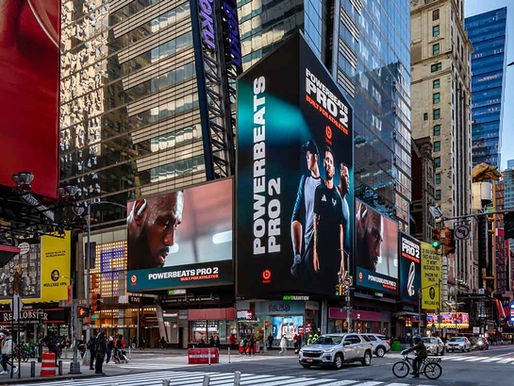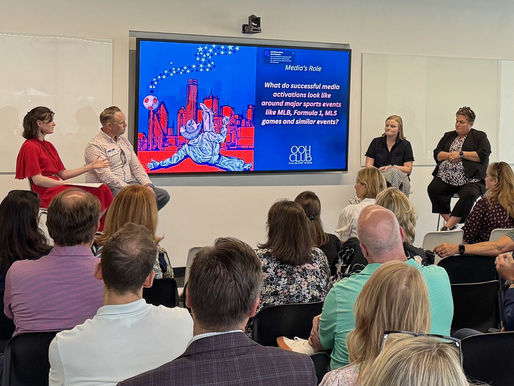top of page
OOH News from PJX Media
Get the latest news and insights from the world of Out-of-Home advertising and the PJX Media Team.


Lulu and Georgia Hit the Streets with Guerrilla Postings in Los Angeles
Lulu and Georgia announced their "Reverie" collaboration with Sarah Sherman Samuel using a strategic OOH guerrilla posting campaign in Los Angeles. See how PJX helped!
1 min read


Perplexity & F1's Lewis Hamilton Use High-Impact DOOH in São Paulo’s Restricted Ad Market
Find out how PJX Media executed a high-impact DOOH campaign for Perplexity and Lewis Hamilton in São Paulo, Brazil, targeting F1 fans despite strict OOH advertising limits.
2 min read


Purely Elizabeth’s Spectacular Moment in NYC
Purely Elizabeth’s NYC activation, secured by PJX Media, is pure obsession. See how their "Taste the Obsession" OOH campaign came to life across bus shelters & Times Square.
1 min read


Jack Daniel's Reaches Adults in NYC with Time-Targeted OOH in a Regulated Market
PJX Media helped Jack Daniel’s promote a Shaboozey concert using time-triggered digital OOH and guerrilla postings to capture the attention of NYC's nightlife and commuter traffic.
2 min read


International Out-of-Home Advertising FAQ
Ready to launch an international OOH ad campaign? Our Q&A covers everything from available countries and formats to lead times and billing.
2 min read


Vuori Serves Up a Multi-Format OOH NYC Campaign during US Open
Learn how PJX Media helped Vuori launch a strategic OOH campaign with billboards, guerrilla postings, and more in NYC to introduce their partnership with tennis player Jack Draper.
2 min read


Out-of-Home 101: The Basics of Guerrilla Postings
Ready to launch a guerrilla postings OOH campaign? Learn the difference between dedicated and guerrilla options, plus what you should know before you start.
4 min read


Dataiku Goes Big with Wallscapes and Large Format Screens
PJX Media activated a striking campaign for AI software company Dataiku in San Francisco, featuring a hand-painted wallscape, a large outdoor wallscape, and digital airport screens.
1 min read


Cost of Billboard Advertising in Los Angeles during the Holiday Season
Planning your holiday ad campaign? PJX Media breaks down the factors that determine billboard costs in Los Angeles to help you make the most of your budget.
3 min read


Capture Your Audience with OOH during Open Enrollment
Cut through the noise this Open Enrollment season. See examples of how to use a strategic mix of OOH formats and hyper-local messaging to drive consumer action.
2 min read


Times Square Out-of-Home Activations with PJX Media
Times Square is an iconic location for OOH advertising. Learn how PJX Media helped brands like Beats, Just Ingredients, and Glossier make their mark with memorable digital and traditional billboard campaigns.
3 min read


Darigold Uses Out-of-Home for National Expansion
Dairy-product company Darigold expanded nationally and launched the “MMMORE TO LOVE” OOH campaign. In Cincinnati, they used digital and traditional billboards, including a high impact digital unit ad near Kroger. PJX Media can help your brand go national too!
1 min read


Figma Gets Visually Immersive with Out-of-Home Media
Web-based design tool Figma leveraged out-of-home advertising in San Francisco and New York to establish a strong brand presence. PJX streamlined the process of OOH media planning and buying, securing static and digital billboards and spectaculars.
2 min read


Sports and Out-of-Home Advertising, a Winning Combo!
Sports and Out-of-Home (OOH) advertising are a powerful team! OOH lets sports organizations - from pro teams to colleges - celebrate wins, promote games, and build hype for new seasons. It's a key play to excite fans and fill seats!
2 min read


DFW OOH Club Shines Spotlight on FIFA World Cup 2026 and the Region’s Explosive Growth
Last week, the DFW OOH Club discussed the future of sports, media, and economic development in North Texas. I co-moderated, highlighting how local media, especially OOH, will share DFW's story globally. The 2026 FIFA World Cup is a key moment, driving investment and visibility, which the OOH industry can't miss.
2 min read


Everand’s First-Ever OOH Campaign
PJX supported Everand's "Read Every Which Way," an out-of-home campaign in Portland, OR, targeting book-loving women near PSU and downtown. The variety of OOH formats, including wallscapes, guerrilla postings, transit, and more, made a strong brand statement in the market.
1 min read


Out-of-Home Complements Integrated Brand Campaign for LPL Financial
For its national ad campaign, LPL Financial launched the “What if you could” campaign. The imaginative storytelling and creativity is disruptive for a financial services brand, learn how PJX supported the campaign with out-of-home media.
1 min read


Programmatic DOOH Campaign for Visit Myrtle Beach
Learn how Visit Myrtle Beach leveraged programmatic digital out-of-home advertising for a multi-market campaign, complete with unique messaging/OOH ads per market.
1 min read


Leveraging QR Codes in Your Out-of-Home Ads
QR codes (Quick Response Codes) simplify information access. After they are scanned by smartphone users, they link to online content. Using them in out-of-home ads like bus shelters and other eye-level formats offers measurable engagement. Read our blog post for more info and best practices.
3 min read


Street Furniture Advertising: An Intro and Why It's Essential for Brands
Street furniture advertising (benches, bus shelters, kiosks, etc.) is a powerful form of OOH media. With eye-level connection and high dwell times, all brands need to be using this format.
5 min read
bottom of page